More great topics coming soon!
American Woodcock (Scolopax minor)
by Ann Taylor
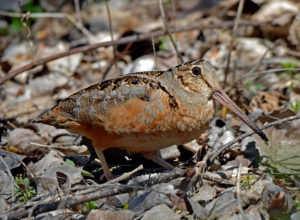 For the past week and a half our pastures have become a show-ring for courting American Woodcocks. For me, their distinctive calls and their spectacular aerial displays are one of the most thrilling harbingers of spring. If you are fortunate enough to live near a field bordered by woodlands, perhaps with wetlands nearby, you too may have these amazing members of the sandpiper family as neighbors.
For the past week and a half our pastures have become a show-ring for courting American Woodcocks. For me, their distinctive calls and their spectacular aerial displays are one of the most thrilling harbingers of spring. If you are fortunate enough to live near a field bordered by woodlands, perhaps with wetlands nearby, you too may have these amazing members of the sandpiper family as neighbors.
I have included three YouTube links below so that you can hear the males persistent “Peenting” serenade and also catch a glimpse of their distinctive whistling, twittering, twisting courtship flight.
At dusk and at dawn (and sometimes by the light of the moon) the males stake out their position in a field, near brushy cover, and start “Peenting”. After a minute or so, they burst into the sky for a whistling and spiraling 100’-300’ ascent. The whistling is thanks to air passing through three specially designed outer primary feathers on each wing. Once they reach the top, they zig-zag back to earth, twittering all the way. An interested female will approach the singing arena, getting closer each time the male takes to the sky. Once he spies this interested female, he approaches her with his distinctive courtship strut. He repeatedly bobs and bows, walking with stiffened legs, and raised wings.
The female scratches out a leafy depression on the woodland floor and incubates her clutch of camouflaged gray and brown eggs (usually 1-4) for 22 days. The downy chicks follow their mother out of the nest within a few hours. Initially, she feeds them bits of worms and small insects and within a few days they begin finding their own food in the soil. Within five weeks the young are on their own.
Very Cool Adaptations:
• A long flexible beak for probing the soil for things like earthworms, millipedes, beetle larvae, and spiders
• Eyes positioned near the top of their heads so they can see predators as they probe in the soil.
• Disruptive coloration blurs their silhouette, allowing them to “disappear” while walking on the woodland floor.
YouTube Links:
The Courtship Flight: https://www.youtube.com/watch?v=ta1fxy0MR2c
Peenting: https://www.youtube.com/watch?v=Ie1SK7rdPUk
Foraging: https://www.youtube.com/watch?v=swHtEAEfGXM
Skunks (Mephitis mephitis nigra)
By Ann Taylor
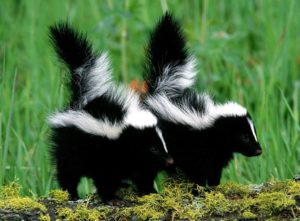
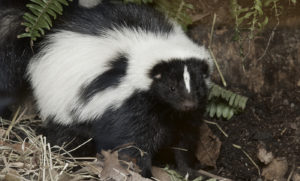
On these spring evenings, as the last of the sun’s rays illuminate the pastures and woodlands, a shift of activity takes place in the animal world. Creatures that hunt for food by day like hawks, squirrels, and chipmunks settle down in their roosts and nests for a night’s sleep. Nocturnal animals like raccoons, opossums and skunks begin to set off for their adventures.
A particular favorite of mine is the striped skunk. These strikingly beautiful mammals amble about the farm on their short little legs in search of tasty meals. They are omnivores eating both plants and animals. In the warm seasons they dine on berries, nuts, crickets, grasshoppers, beetles, mice, frogs, bees and turtle eggs (a true favorite). They spend hours digging in rotting logs and in the top layers of the ground with their long curved front claws exposing beetle and cicada larvae, salamanders, sowbugs, and earthworms.
For many years, skunks were considered members of the Mustelid or weasel family but thanks to recent genetic evidence they are now classified in their own family, Mephitidae. Skunks are relatively quiet mammals. They are content to go about their territories avoiding confrontations. The characteristic that they are most famous for, spraying, is actually their last line of defense.
When disturbed, skunks initially raise their tails and stomp their front feet as a warning, but if this demonstration isn’t taken seriously, then a skunk can continue to face the intruder while curving its tail end around, bending its body into a “U”. Skunks have two scent glands at the base of their tail. When necessary, they squeeze their sphincter muscles, two nozzles emerge like fire hoses and shoot streams of rain-sized droplets as far as fifteen feet. The spray fans out into a 45-degree arc so that it will even hit a moving target. Few animals, aside from the inexperienced, dare to challenge the skunk, perhaps this accounts for their calm demeanor.
The skunks’ characteristic black and white pattern serves as a warning to most animals but as an invitation to the great horned owl. Lacking a keen sense of smell, this large predator is powerful enough to swoop down, grab a skunk with its talons and whisk it away to a nearby roost.
By first light most skunks disappear into hollow logs or large brush piles, or into underground burrows that have been vacated by woodchucks. Next time you encounter a skunk, just take a few steps back and quietly admire these clever neighbors. During the summer you may even be fortunate enough to observe a mother followed by a single file parade of up to eight waddling youngsters- an unforgettable sight to behold!
Spotted Salamanders (Ambystoma maculatum)
by Ann Taylor
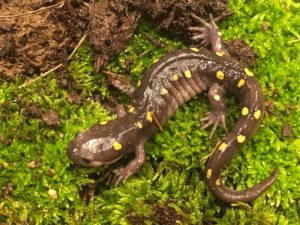
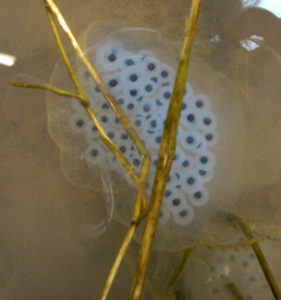
One of my favorite things to do in the spring is to search for spotted salamanders. They are beautiful woodland salamanders, eight inches long, shiny and black, with two irregular rows of yellow/orange spots, running down their backs from head to tail.
Even though these large members of the mole salamander family, Ambystoma, are not uncommon, many people have never seen them. This may be because they are quite secretive and spend most of their lives hiding beneath leaf litter and rotting logs, or in subterranean tunnels made by small burrowing animals. They normally venture out onto the woodland floor on moist nights in search of tasty prey like worms, millipedes, and a variety of insects.
However, in mid to late March, on the first warm rainy nights, spotted salamanders are not shy at all. They emerge from their winter burrows by the hundreds- then scramble over wet leaves and melting snow, marching with great determination towards their traditional breeding ponds. Some may travel as far as an eighth of a mile.
If you grab your flashlight and boots and head out for your local vernal pool or small woodland pond, you will have a great chance of attending their spring gathering, and it is something you and your family will long remember!
The smaller males are the first to plunge into the icy waters. As the females arrive over the next few days they will all begin to swim in a large circle. Over time the pace quickens and they move dizzily over, under and around each other. If you watch very closely you may see a male and female pair off and swim in their own circle. The male will rub the female under her chin with the back of his head. If she seems receptive he drifts down to the bottom of the pond and settles on a leaf. Clasping the leaf with his back legs he deposits several white cones of jelly about ½” high, each one is packaged fertilizer called a spermatophore. The female then settles down over the spermatophore and picks it up with the edges of the cloaca at the base of her tail and pulls it into her body (some females pick up multiple cones from different males). The pairing is now complete and they each go their separate ways.
Shortly thereafter the female will lay her fertilized eggs in several golf-ball-sized clumps, attaching them to submerged vegetation. One female will lay an average of 200 eggs before heading back to the woodlands. Once the gelatinous egg masses emerge, they swell and can become the size of a fist. The salamander eggs are easy to distinguish from those of the early spring wood frog eggs, which are laid at similar times, because the salamander eggs are surrounded with an additional, thick layer of protective jelly. Inside each egg there is a small dark spot-this is the larval salamander. In just a few days it will have the beginnings of gills. In about four weeks, when they are ready to hatch, each larval salamander will have four stout legs, long feathery red gills, and a tail especially designed for swimming. The young spotted salamanders will remain in the pond throughout the summer eating amphipods and other small creatures. By September when they have metamorphosed into their juvenile stage they will move out into the woodlands, where they will live and mature in preparation for their own nocturnal migration back to their birth pond.
Note: Whenever you observe amphibians (frogs, toads, salamanders) please be careful! We suggest that you look and not touch. Their skin, which also serves as a supplemental breathing organ, is very delicate and susceptible to chemicals from hand sanitizer, lotions, soap, insect repellent, and the like.
A great read for young naturalists: The Salamander Room by Anne Mazer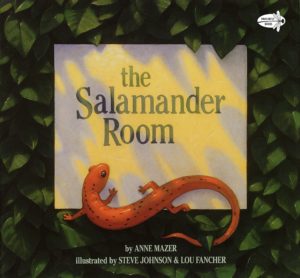
Flying Squirrels
by Ann Taylor
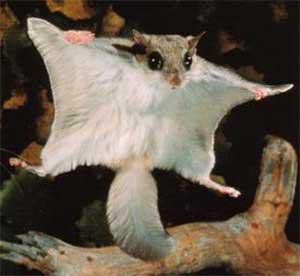
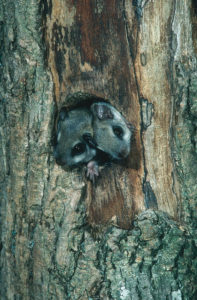 Getting to Know Your Wild Neighbors- They Glide Through the Trees with the Greatest of Ease!
Getting to Know Your Wild Neighbors- They Glide Through the Trees with the Greatest of Ease!
Once the sun goes down in our woodlands, some spectacular aerial acrobatics begin, as our most endearing nocturnal mammals emerge from tree hollows, and skillfully glide through the trees in search of arboreal delights.
Nature has equipped Flying Squirrels with a bounty of physical and behavioral adaptations that make their lives in the treetops possible. A large flap of skin stretches between their wrists and ankles (the patagium), and a smaller flap is connected to their ankles and tail (uropatagium). Together, these membranes serve as an airfoil or parachute and allow the squirrels to glide from tree to tree at speeds of up to 20 miles per hour. A typical leap might be 30’, however when their launch site is 60’ up in the treetops, longer glides have been measured in excess of 200’. The task of steering is accomplished with its arms, legs, and flattened rudder of a tail. An extra piece of cartilage at the end of each “wing” can be turned upwards, providing stabilization. At the critical moment before landing, the tail serves as a brake, and the squirrels alight with their heads pointing up the tree. Extra thick padding on their feet cushions the impact as they land. With their sharp claws and long legs, flying squirrels easily scamper up the trunk to gain altitude before taking off for their next leap.
We have two types of flying squirrels living in Connecticut, Northern (Glaucomys sabrinus) and Southern (Glaucomys volans). Southern Flying Squirrels have white fur on their underside and they are between 8”-10” long (including their 4” tails). Northern Flying Squirrels’ belly fur is gray at the base, and they are between 10”-12” long including a 5” tail.
Both species make their homes in our woodlands and wooded backyards. Favorite real estate includes abandoned woodpecker holes, natural tree hollows, old nests of gray squirrels, and even nest boxes that people have put out to attract screech owls or wood ducks. I should mention they are partial to attics as well, especially if trees are within gliding distance.
These little squirrels are omnivores. They dine on foods such as lichens, fungi, hickory nuts, acorns, seeds, flower blossoms, leaf buds, fruit, and insects. Southern Flying Squirrels have a bit of a reputation for eating bird eggs and even mice. In the late summer and fall, these busy little rodents can store thousands of nuts for the winter! Like other squirrels, they are thought to have a scent gland on their cheeks so they can “label” their nuts before burying them. They also bring a good supply of food into their homes for easy access during bad weather. Flying squirrels often den together during the colder months to conserve heat.
Their small size makes them an attractive meal for nocturnal predators like owls. Thankfully, their enormous ebony eyes are designed for night vision, they maneuver evasively around tree trunks, and they know how to “freeze” in place, blending in with a tree trunk, until danger passes.
If you are wondering if you have flying squirrels in your woodlands, look at the base of trees with cavities. They have a characteristic way of opening their nuts. You may never see one, but its inspiring to know that we have such extraordinary wild neighbors. Check out their aerial acrobatics online, you will be amazed!
Please watch our video on these fascinating little creatures here.
Wonderful YouTube links:
Flying Squirrel Glides at Night | North America from the DiscoveryChannel: https://www.youtube.com/watch?v=4J3U3QqOxpY
Flying Squirrel from CTnaturalist:
https://www.youtube.com/watch?v=JHQ4wwK7ryw
